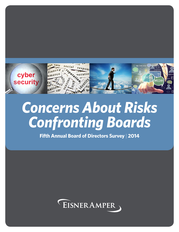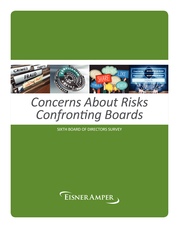Description
NEWS
Trends & Developments | 18
EisnerAmper LLP Announces
New Executive Corporate Structure
Spurred by significant growth, our firm recently
announced a new executive corporate structure that
will enable us to manage our expanding capabilities and
resources across rapidly growing markets, service lines
and regions, both domestically and internationally.
Charly Weinstein, CEO, said “Delivering exceptional
client service, attracting the best people and building
national practices are the driving factors behind the new
organizational structure. Our firm has grown considerably
in size in just a few years, and as a result we are a
significantly more complex organization.”
The new structure is designed to address complexity
while preserving the firm’s differentiating characteristic
of being highly responsive at the partner level. “A key to
our success has always been our ability to be nimble; to
address client needs quickly and directly,” Weinstein said.
“We’ve always operated internally on close contact and
collaboration, and our new structure is driven by the need
to continue along those lines.”
The firm has recently expanded its geographic reach
with offices in Miami and Broward County, Florida;
Sacramento, California; and Israel. The formation of
EisnerAmper Global resulted in the establishment of
practices in Dublin, Ireland and the Cayman Islands.
Weinstein noted that “given our growth and plans, this is
the right time to implement an organizational structure
that enables us to serve the needs of our growing client
base, while setting the stage for future growth as well.”
www.eisneramper.com
© 2016 EisnerAmper LLP This publication is intended to provide general information
to our clients and friends.
It does not constitute accounting, tax, or legal advice; nor is it intended to convey a thorough treatment of the subject matter. Jay Weinstein, Managing Partner – Markets and Segments, is responsible for executing business strategies for existing markets and segments and identifying emerging opportunities. Jay works closely with practice leaders to develop goals and success metrics, as well as business development capabilities. Christopher Loiacono, Managing Partner – Services, is responsible for the growth and quality of service offerings. Chris works with service line leaders to integrate client services and ensure the firm has the talent, capabilities and capacity to deliver high quality work and exceptional client service across existing and potential lines of business. Chris also works to drive efficiency efforts and manage costs of services. Michael Breit, Managing Partner – Regions, will concentrate on the growth and expansion of the firm’s offices.
Working closely with the partners-in-charge of the offices, Michael will set goals and monitor results for profitability and local market penetration. Along with Jay and Chris, Michael will also seek to identify M&A opportunities, both geographically and in practice markets. Charly Weinstein said, “There are limitless possibilities for EisnerAmper on the horizon and under our new leadership team we’re ready to reach out and make them realities.” .
It does not constitute accounting, tax, or legal advice; nor is it intended to convey a thorough treatment of the subject matter. Jay Weinstein, Managing Partner – Markets and Segments, is responsible for executing business strategies for existing markets and segments and identifying emerging opportunities. Jay works closely with practice leaders to develop goals and success metrics, as well as business development capabilities. Christopher Loiacono, Managing Partner – Services, is responsible for the growth and quality of service offerings. Chris works with service line leaders to integrate client services and ensure the firm has the talent, capabilities and capacity to deliver high quality work and exceptional client service across existing and potential lines of business. Chris also works to drive efficiency efforts and manage costs of services. Michael Breit, Managing Partner – Regions, will concentrate on the growth and expansion of the firm’s offices.
Working closely with the partners-in-charge of the offices, Michael will set goals and monitor results for profitability and local market penetration. Along with Jay and Chris, Michael will also seek to identify M&A opportunities, both geographically and in practice markets. Charly Weinstein said, “There are limitless possibilities for EisnerAmper on the horizon and under our new leadership team we’re ready to reach out and make them realities.” .
Technology Presentations
+
Technology Sub Categories














